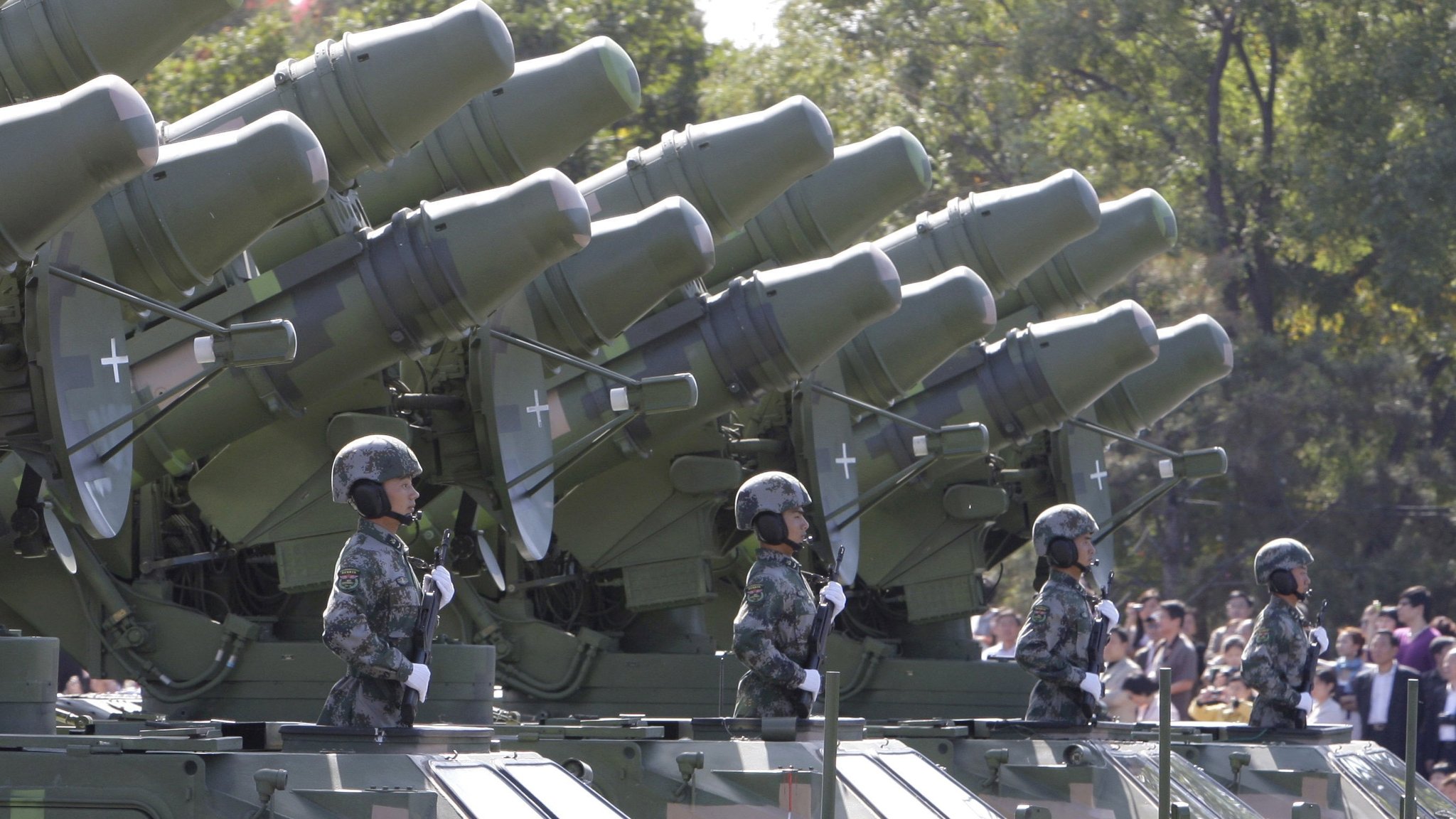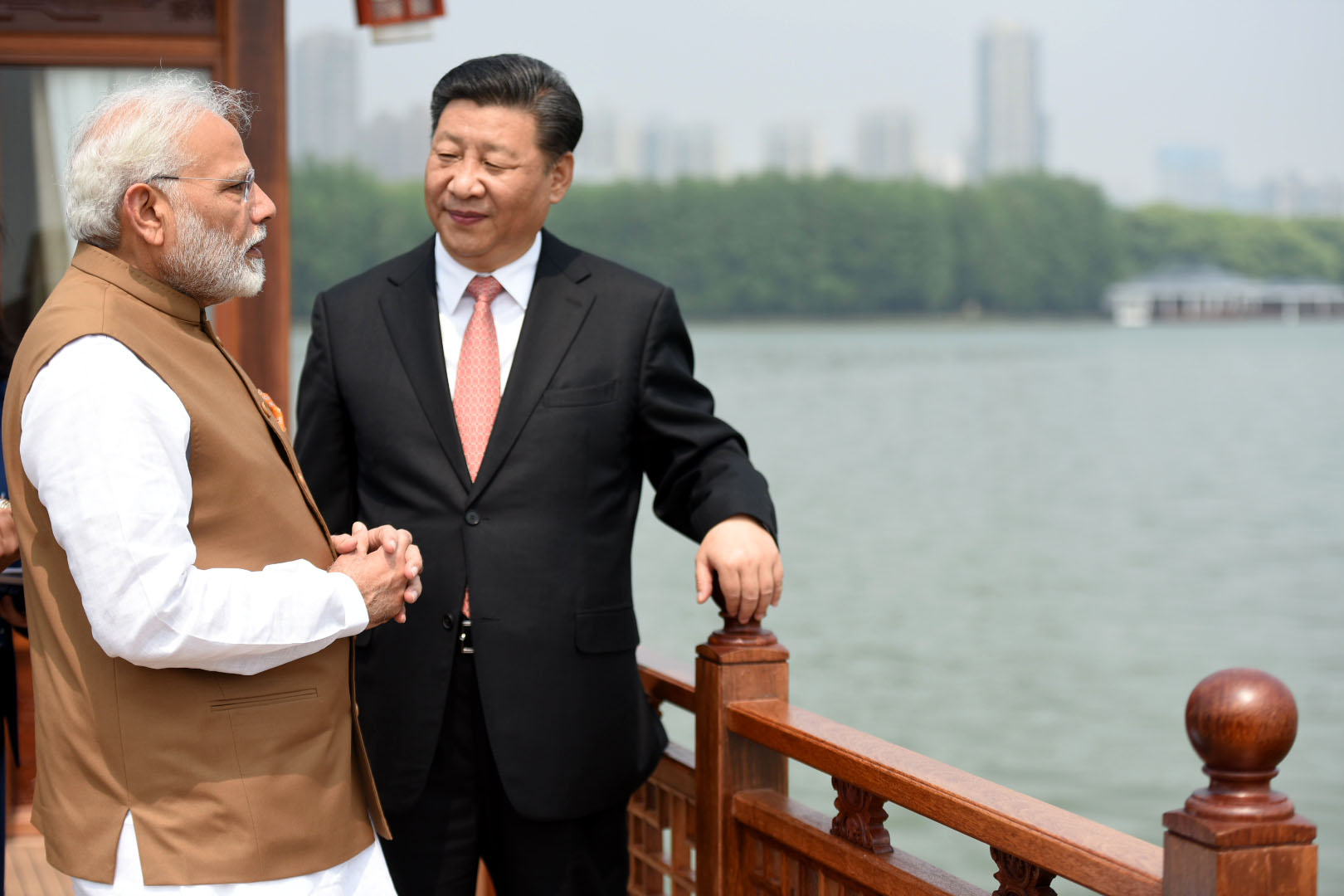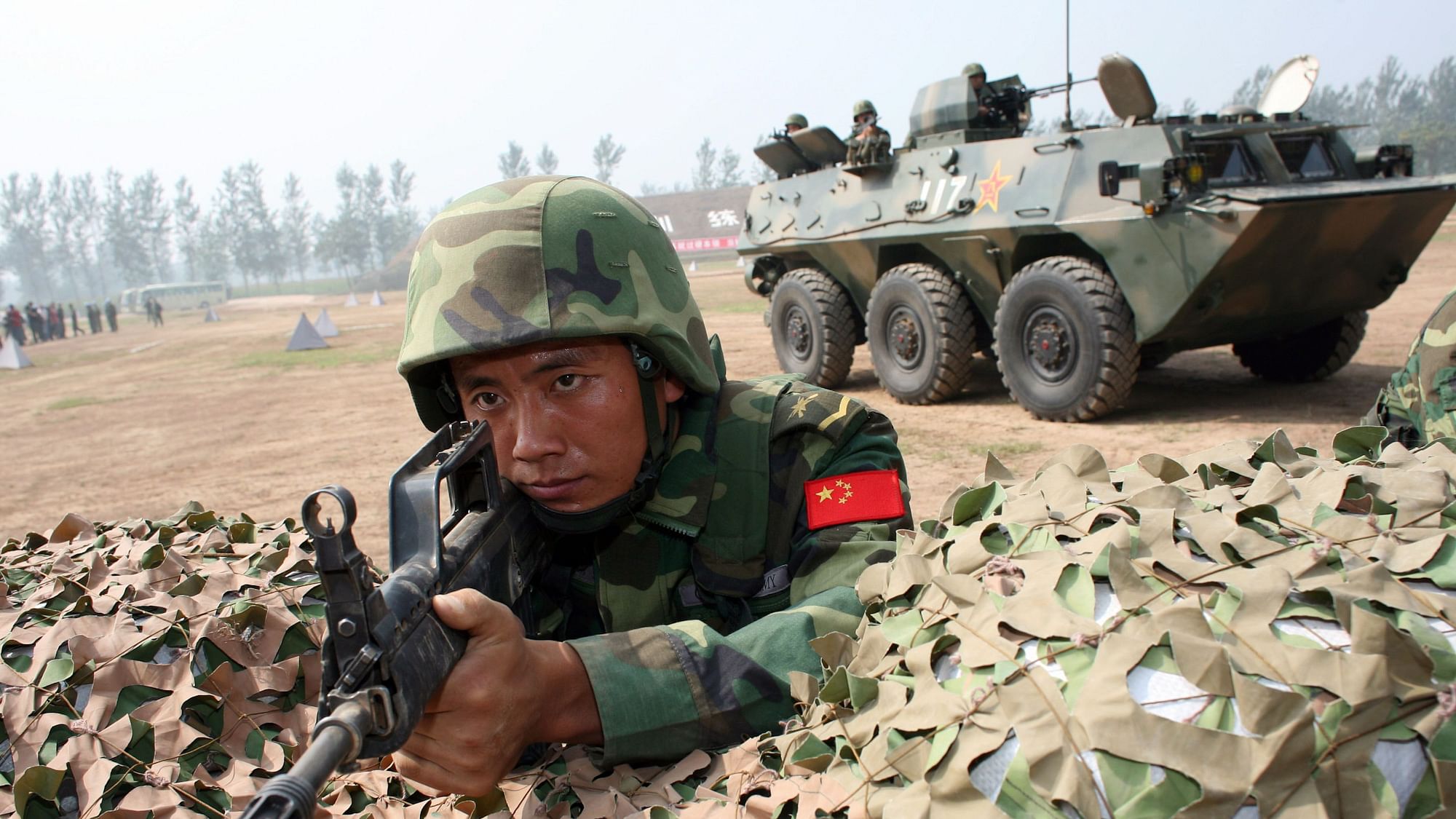
The border deadlock between India and belligerent China is fraught with the danger of escalating into a full-fledged military confrontation, writes Gopal Misra
The People’s Liberation Army or PLA equipped with the state-of-the art weapon systems with an assertive political will of the Chinese President, XI Jinping, appears to be preparing for a prolonged military operations in the Eastern Ladakh to finally shift the military balance in its favour. The ongoing corpse commander level talks between India and China may not yield any substantial results, while China continues to nibble the strategic territories, while talking for peace.
Apart from further consolidating its gains in the high Himalayas, the PLA agenda is also to enable its protege, Pakistan, to pursue its Kashmir agenda more vigorously. The latest satellite images of the construction of a bridge for linking the northern and the southern banks of the Pangong Lake appears to be a part of a larger political and strategic agenda. Simultaneously, China has announced new names in Chinese for as many as 15 places, including a peak, in Arunachal Pradesh.
The foreign office in New Delhi has been prompt in criticizing the Chinese for renaming the Indian places; and also assured that the January 3 pictures of the Pangong Lake reveal the areas, which have been under Chinese control for the past six decades. However, the Indian spokesman, Arindam Bagchi, should have been reminded that in 2017 China had renamed six places in Arunachal Pradesh following the visit of the Dalai Lama. In 2022, it is quite intriguing that why did China repeat the announcement. The answer, perhaps, could be that now under the law enacted in October 2021, PLA is fully empowered to take steps against those occupying the Chinese territories.
A temporary truce between India and China after the Galwan clashes was arrived at following the Russian pressure, but the situation continues to be grave. India, perhaps, is rightly apprehensive of a new multilateral Chinese offensive with a surprise element against her anytime anywhere. It could be much more devastating than the skirmishes with a number of fatalities India had faced in June 2020.

It is now an established fact or fate accompli that being a frontline state having borders, approximately more than 2500 kilometers long with her northern neighbour, China, India has to face the conflict, whenever it erupts, without any physical support of any other power, especially the USA and Russia. The elephantine memory of Indians has not forgotten that during the 1962 conflict, the then US President John Kennedy, had declined to give any air cover to the Indian forces outnumbered by the PLA. The crucial air support was denied to India, which could have saved her humiliation. However, in 1967, during the regime of Prime Minister Indira Gandhi, the Indian forces trounced the Chinese in the Nathu La, and four years later, Bangladesh could achieve its independence with India’s active support. With these developments, the Chinese mischief in the northeastern region was contained for a few decades.
During the post-1962 conflict years, India was refused high-tech weapons to challenge the growing belligerence of the then Chinese leadership. Instead, the USA and its western allies extended massive economic support and latest weapon systems to Pakistan. It emboldened the then Pakistani dictator Field Marshal, Ayub Khan, to invade India three years later in 1965. During the 1971 Bangladesh war, the then US President Richard Nixon had asked China even to attack India to allow the Pakistani army to decimate Bengali Muslims. It is estimated the genocide endorsed by America and the western powers had led to the mass killings to the tune of 20 million people, including the rape of 30 million young Bengali Muslim women.
India must prepare for a larger conflict
With a note of caution, a distinguished former Indian diplomat, L.L.Mehrotra, told this journalist that the recent developments at the Pagong Lake and the renaming of 15 places of Arunachal Pradesh in Chinese language should aggressively be countered by Indian diplomacy by initiating a worldwide campaign against China, a permanent member of the UN Security Council. The permanent members of the UNSC have the power to veto, whenever they consider global peace is threatened. Therefore, if a permanent member indulges in provoking violence or conflict, it should be stripped off the veto power, India should not hesitate to demand, he suggested.
Mehrotra has also expressed his ‘anguish’ that India has already conceded much space in diplomacy to China by not insisting for the implementation of the McMahan line. The Line of Actual Control (LAC) or Line of Control has in fact given unnecessary space to China in maneuvering its position on the borders. He has also cautioned that it is a foolish logic that the Nehru regime had given much more land to China than the present rulers. The Chinese agenda continues to occupy strategic positions in the Himalayas.
Most of the people, who either have been in the sensitive field of diplomacy or have been manning India’s security establishment do not rule out a renewed Chinese military activities on her borders with Tibet in 2022. The Chinese military adventurism is closely linked with her agenda to claim its military superiority in Asia as well as worldwide. It has already established itself as the economic superpower in the world trade and financial systems. The Indian perception by and large is that the ongoing unnecessary military confrontation between India and China is a part of a larger Chinese design for establishing its unquestioned writ in the world, especially when in 2049, China celebrates 100 years of the Communist takeover.
Attention to Science and Technology

India’s security establishment both political and military, has ruled out any lasting solution to the border impasse between the two Asian giants in near future. The Indian efforts must be augmented by more attention to technology development. There is near unanimity that the successive governments during the past three decades have failed to evolve a multidimensional Indian strategy accompanied by 24×7 vigilance to tackle China’s never-ending ambitions in the region as well as across the world.
Compared to the Chinese initiative in recent years in the field of science and technology, India has already missed the opportunity for updating her technologies. While China invests 2,5 percent of its GDP in science and technology, India has earmarked only .75 percent of her GDP in the higher pursuits of knowledge. Therefore, it is not surprising that Germany has decided to work with China in the development of new technologies. After the USA and Japan, China is getting the largest numbers of products to be patented.
New Strategies and Weapons
During the past 10 years, the Central Military Commission of China under President XI Jinping has reformed the traditional military planning and empowered it with a civil-military integration. The new inventions in the field of artificial intelligence (AI) have further augmented the Chinese army. The Chinese decision to empower navies of Pakistan, Bangladesh and Myanmar with modern frigates and submarines has quietly altered the balance of power in the region at the cost of Indian defence preparedness.
It is seldom discussed in Indian media or even at the conferences of the think tanks in India about the Chinese initiatives during the past one decade. Since 2011, Rear Admiral Wang Yu, who was the key person in the Naval Equipment Research Institute, has helped in refurbishing the naval ships with new software plaforms. Major General Ye Zheng, who had been a part of the Military Planning since 2011 has helped in upgrading with new research. Therefore, the Indian navy has to notice these developments in the South-Asian region and how to tackle a conflict situation and how these local powers would respond needs to be examined. There is a unanimity among India’s military and civilian leaders that India should never expect any world power, USA and Russia, would physically intervene on her behalf, if ever any confrontation with China takes place on a larger scale.
India’s Proximity with America
It is difficult to predict that in spite of the much talked about human rights issues, the US-led west would ever seriously impose even financial sanctions against China. The Indian scholars and defence experts are in unison that Prime Minister Narendra Modi government should fine-tune its China policy that too without rhetoric or loud pronouncements. It is being asked why the proposed joint efforts of India and China for peace and prosperity known as the Wuhan Declaration could not make any headway so far. It goes to the credit of Modi that he met XI Jinping several times to work out a stable relationship with India’s northern neighbor. He, like his predecessors, too wanted to rope in China for the welfare and progress of the region, but now he has to redeploy the country’s resources to guard the borders. Since, the conflict with China is going to be multilateral and multi-dimensional, the strategy to meet the challenges has to be much wider incorporating financial, industrial and technological sectors.
Meanwhile, Ambassador Mehrotra and many others do not endorse the suggestion of the foreign affairs experts like G.Parthasarathy that China is getting ‘angry’ with India for her growing proximity towards America. The ground reality is that despite anti-China rhetoric of the Biden administration, the American investment in China is going on unabated. China, thus, empowered by the continuous flow of the American capital and the state-of-the art technologies, has finally acquired the coveted Superpower status in world trade and is keen to impose its writ in Asia. The Chinese strategy appears to be that if necessary with military confrontation, India being the frontline state has to be targeted and pacified.
China’s aggressive posture from the eastern Ladakh to India’s north-eastern region comprising the border state of Arunachal Pradesh and the areas overlooking the narrow chicken neck of 15 kilometers width that connects India’s mainland with her northeastern eight states, seven sisters and one brother, needs to be studied in a wider spectrum of China’s desire to replace USA in military terms as a Superpower too.
The Chinese intrusion in the northeastern states, the seven sisters, Arunachal, Assam, Manipur, Meghalaya, Mizoram, Nagaland, Tripura and the brother, Sikkim, has been for the past four decades or so. It never hesitated in supporting insurgents in Mizoram, Nagaland, Tripura and even in the Garo hills of Meghalaya. In spite of India’s friendly overtures, China never stopped meddling in the region.
The Chinese War Game, Wei
It was a mirthless quiet misty Saturday morning on January 1, 2022, when the sun ushered in to herald a new hope or optimism. New Year’s Eve was a low-key affair, which in previous years used to be accompanied by much fanfare for raising hopes and promises. The past two years, however, have been full of challenges under the deadly spell of the pandemic, Covid-19. In spite of this, a large group of soldiers of two countries, India and China, greet each other to welcome the New Year that too amidst the snow-capped Himalayan ranges, where one has to make additional efforts to breathe in their respective camps at the breath-taking heights. The oxygen gets thinner in these difficult terrains, where our soldiers keep round-the-clock vigil. However, they retained their New Year spirits to greet the Chinese soldiers with sweets, forgetting for a while that only in June 2020, they had skirmishes which had turned fatal with heavy casualties on both sides. It was the same site, the Galwan Valley, where the forces have been facing each other for the past 20 months.
The exchange of pleasantries were short-lived. It surprised many, especially those, who had exchanged sweets only a few hours ago, to be informed by their seniors that the Chinese have shared their flag on a number of Chinese social media platforms in a bid to claim the possession of the territory they wanted to occupy. The Indian side too promptly shared the Tri-colour to counter this propaganda.The Chinese wargame, Wei, differs from chess, with its surprise element. The Indians are aware of these Chinese tactics. Therefore, few in India were surprised, when amidst this provocative action, the Global Times, a Chinese English daily, published a news article renaming as many as 15 places, including a peak, of Arunachal Pradesh in Chinese language. The daily quoting China’s Ministry of Civil Affairs also announced that from January 1, 2022, China shall be enforcing the new names with the necessary marks. It is being done as per the provisions of the legislation enacted in October 2021.
The year 2022, thus, begins with the apprehension of yet another confrontation, which could be on a much larger scale between the forces of the two Asian countries. The Indian policy makers, both in the South Block (the offices of the three key functionaries of the union government, the Foreign Minister, the Defence Minister and the Prime Minister are housed in this building), and the various think tanks comprising well-known figures in Indian diplomacy, former top army officers and reputed academics are keeping their fingers crossed. Their fear of a repeat of the Galwan experience cannot really be ruled out. Their initial reaction is that India must be ready for another flare-up, but the timing and the place will be decided by China.
Meanwhile, there is a consensus that instead of blaming Jawaharlal Nehru, India’s first Prime Minister, for India’s debacle in the 1962-war with China, it is high time that Narendra Modi should realize that “India must not budge from the Mcmahon Line agreed between the British India and Tibet in Delhi in March 24-25 in 1914. It was a follow-up of the Simla convention also attended by China held earlier. China refuses to endorse the Mcmahon line on the plea that Tibet was not a sovereign country. It also claims that Arunachal Pradesh is the southern Tibet, therefore it should be under Chinese control. Interestingly, China has already bifurcated the larger Tibet to further dilute Tibetan nationalism.
PLA occupies new areas during India-China summit
During the years, 2014 and 2015, India was enthusiastically hosting the Chinese President XI Jinping and his colleagues in Ahmedabad and New Delhi respectively, but during these meetings at the highest level, PLA did not hesitate to occupy new Indian territories of Chumar village in eastern Ladakh, south of the Tso Moriri lake, on the bank of Parang River and Demchok for further consolidating its claims. The Indian military sources reveal that a few days before the arrival of Jinping in India, more than 1000 troupes were moved to the place. It is necessary to note that the Chumar border was an international border, which was never in dispute. However, in its bid to have a straight connection between the point 4925 to point 5318, China has claimed it to be a disputed area and tried to occupy it.
It raises two questions, firstly, why Narendra Modi is reluctant to assert Indian claims on the basis of Mcmahon Line, and secondly, whether XI Jinping could really be trusted with his statement that he genuinely seeks peace with India. XI Jinping also heads the country’s military commission, it cannot be believed that PLA could assault Indian positions without his approval. Thus, the PLA indulges in the old Chinese wargame, Wei, which approves deceit or XI Jinping genuinely believes his Indian hosts are just naives, who could be easily manipulated.
Chinese’ open support to terrorists
During the informal summit at Wuhan in China between Narendra Modi, and XI Jinping a declaration was signed in April 2018, agreeing to jointly oppose terrorism, as a threat to global peace, but China within next eight months supported Pakistani terrorists and terror outfits. In February 2019, it refused to support the proposal of other four permanent UN Security Council members, UK, France, Russia and USA to declare the Pakistan-based terrorist Azhar Masood, chief of the Jaish-e-Muhammed and one of the key accused of the terrorist attack of 26/11 in 2008 in Mumbai an international terrorist.
Standoff fails to slam brakes on imports from China
In spite of the rhetoric of the ‘Atma Nirbharta’ or self-reliance, accompanied by the boycott call following the China-India standoff on the high Himalayas, there is a visible surge in imports from China. During the 2014-15, when the BJP-led NDA (National Democratic Alliance) came to power, the imports from China were to the tune of USD 42.33 billions against India’s exports of 12.26 billion USD. During the period April-December 2021, the Chinese imports had already crossed USD 85 billions and Indian exports to China, that too of the low-value raw materials, was just 12.26 billions USD. However, despite massive imports from China, it has continued its belligerent and aggressive posture against India on the borders as well as in various UN forums.
China upstaged in Kazakhstan
The Russians, well-aware of the Chinese double speak, quietly upstaged China in Kazakhstan on January 9, when its forces foiled the coup planned by pro-Chinese Islamists in the country. In India, few expected any breakthrough in the 14th round of the military-level talk between the Leh-based corps commander Lt. General Anady Senguta and his Chinese counterpart on January 12.
The Chinese as usual maintained their belligerence of retaining the territory they had grabbed, but the Indian side remained firm with its proposals and did not betray any nervousness or be intimidated by their arrogance. On the other hand, it appeared that the Chinese officers were not properly briefed or mandated by their superiors in Beijing. They could not spell out any proposal for permanent peace on the border.
Earlier, the Chinese policy of psychological warfare and double-speak received a big jolt, when on January 7, the radical Islamists, believed to be close to China, failed to topple the government of president, Kassym-Jamaqt Tokayen, in Kazakhstan due to the timely Russian intervention. Tokayen, though educated in China, perhaps was well aware that the Chinese could not be trusted; he promptly sought for the Russian forces. Thus, China failed to install a proxy government in Kazakhstan, a large landlocked country in Central Asia with vast mineral resources.
Chinese rant on India’s support to Tibet rebuffed

Earlier, just a few weeks before the new aggressive posture in Ladakh, number of Indian law makers received a missive from the Chinese embassy to refrain from attending any meetings endorsing Tibetan freedom.
On December 22, 2021, a number of prominent Indian politicians attended the meeting of the All-Party Forum for Tibet. They included the Union Minister of State, Chandrashekar, prominent Congress Party leaders, Jairam Ramesh, Manish Tewari, BJP’s Maneka Gandhi and it’s convenor, Sujeet Kumar of Biju Janata Dal. The speaker of the Tibetan Parliament in exile, Khenpo Sonam Tenphel, represented Tibet.
The political counsellor of the Chinese embassy in New Delhi, Zhou Yongsheng, in a missive to the Indian lawmakers has asked them to ‘refrain’ from supporting the cause of Tibetan independence. This communication has received sharp criticism from the Indian side. It is being pointed out that the Tibetan government in exile has been seeking autonomy within China. There have been a series of confidential meetings between the Tibetan representatives and Chinese leadership. The formula of having two systems within a country, which was applied in Hongkong could have paved the way for ending the six decades of standoff between the Communist regime in Beijing and Tibetan leadership. However, with the end of the autonomy in Hongkong, the prospects of a solution to the Tibetan issue is now ruled out. The Chinese provocation could be traced to the new aggressive posture being adopted in the third year of the ongoing spell of the Covid-19 pandemic, with its ever-changing strains.
‘India has to learn to live with her unpredictable northern neighbour’

India’s spectrum of political opinion, irrespective of the ideologies, appears to have baffled the lawmakers as well as those who man India’s security establishment. General (Retd.) V.K.Tiwari, who has recently superannuated, feels that “India has to learn to live with her unpredictable northern neighbor”. He appreciates the manufacturing of better guns and artillery in India, but the technological gap between India and China is getting wider with each passing day.
He also cautions that China’s friendliness should not influence our key strategic decisions. The task for the policy makers is becoming much more difficult and complex with each passing day. Since India is a frontline state, she has to face the unending aggressive posture and belligerent attitude of China, she always has to be in the state of preparedness for facing any eventuality. In their bid to please China, the US-led western powers have already abandoned the hapless people of Tibet. The issue, however, hit the headlines in the western media in 2020, when China suddenly ended the autonomy of Hongkong, thus dumping the assurances it had given to the democratic world. China had promised to retain its democratic system for a period of 50 years. It was returned to China on July 1, 1997 after 156 years of British rule. Earlier, a joint statement was issued by China and Britain in1984 that China would retain Hongkong’s autonomy under the principle of “two systems in one country”.
Except for a few statements condemning China, the western powers are hesitating to take any substantial decisions against China. The Americans have allowed China to continue to print the Hong Kong dollars, which enjoys the prestige of an international currency like USD.
Putin plays down Taiwan
The US President, Joe Biden, adopts “tough posture” on the issue of Ukraine during his summit with Putin, but he refrains from using any harsh words while dissuading China from occupying Taiwan by force. The assessment in the South Block is that the Chinese proxies would intensify worldwide pressure on Taiwan in coming months. The recent decision of Nicaragua to close down the Tainwanese embassy to be replaced by the Chinese mission is such an example.
There could be two reasons: firstly that during the past two decades, the Chinese penetration in the American systems has gone so deep that the US administration finds itself ‘helpless’ in dealing with China; secondly, the Americans consider Russia a much bigger threat than China.
Therefore, the much-trumpeted QUAD comprising Australia, USA, Japan and India too appears to be a non-starter alliance. Meanwhile, most of American allies including Australia, Philippines have joined the Chinese sponsored free trade agreement, Regional Comprehensive Economic Partnership (RCEP). It will enable China to establish its economic supremacy in the Asia-Pacific region. India has not joined the RCEP, but bilateral trade has reached USD 100 billion.










